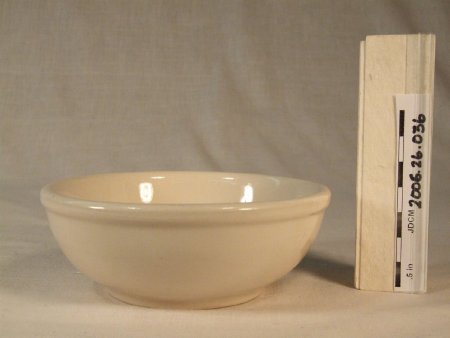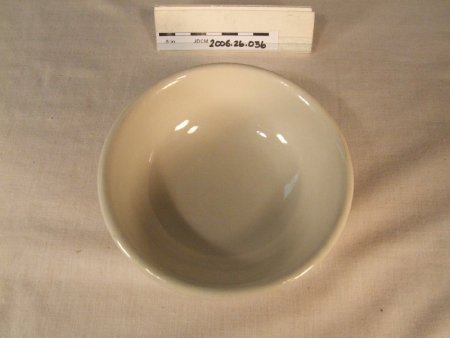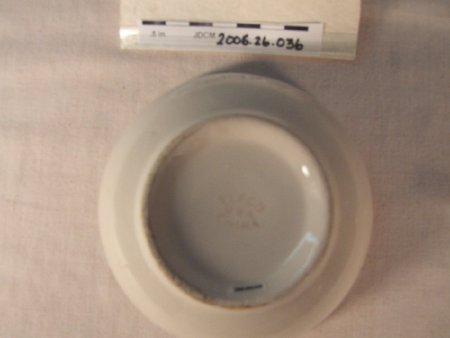Collection:
Juneau—Douglas City Museum
Object ID:
2006.26.036
Accession#:
2006.26
Credit Line:
Donated by LInda Wahto.
Object Name:
Bowl
Title:
White Ceramic Bowl "TEPCO USA"
Description:
White ceramic bowl. Bottom of bowl has "TEPCO CHINA USA" printed on the bottom.
TEPCOWARE
From Americian Craft Magazine
Aug/Sept 1982
Written By Joseph Heaven
http://www.e—z—smith.com/amcraft.html
The Technical Porcelain and China Ware Company is now a part of California history, but at its height John Pagliero's "Pottery" could produce 30,000 dishes a day. Technical Porcelain and China Ware Company founded in 1918 by John Battista Pagliero in El Cerrito, California. The ware was universally known by the company's nickname and trademark, "Tepco." Pagliero was born in 1883 in the Piedmont countryside north of Turin, Italy. Fourteen years old when his father died, he and his brother went to work in a Faenza—style pottery near their home. As a journeyman potter, John went to France and stayed to work as a "faiencier." In 1908 the brothers emigrated to California , where they both found work at Carnegie Brick and Faience in Livermore. The building supply trades were booming during the restoration of San Francisco after the 1906 earthquake.
In 1918 John Pagliero, who by this time was the superintendent of a porcelain casting plant, established Tepco in his backyard. By 1925, Pagliero had left his superintendent's job and moved Tepco to a site alongside the Santa Fe Railroad track. (When this first factory burned down in 1947, it was replaced by a 200— by 500 foot structure consisting of a low brick building for offices and a barrel—vaulted, reinforced—concrete production room.) He converted the existing building to a plaster shop for making molds and installed Pasquale Rosatti as master. Rosatti's early molds and the corresponding metal jigger tools produced exceedingly heavy, wide—rimmed china; when jiggered and dry, the ware had walls three—eighths of an inch thick. Later Rosatti made molds that turned out thinner, lighter ware with scalloped edges and narrow rims, as well as coupes (rimless plates and bowls). The quarter—inch walls were semi translucent.
Restaurants in the West are still serving on Tepcoware. Shelves at lunch counters and coffee shops are stacked with the thick, clunky white or tan dishes.
TEPCOWARE
From Americian Craft Magazine
Aug/Sept 1982
Written By Joseph Heaven
http://www.e—z—smith.com/amcraft.html
The Technical Porcelain and China Ware Company is now a part of California history, but at its height John Pagliero's "Pottery" could produce 30,000 dishes a day. Technical Porcelain and China Ware Company founded in 1918 by John Battista Pagliero in El Cerrito, California. The ware was universally known by the company's nickname and trademark, "Tepco." Pagliero was born in 1883 in the Piedmont countryside north of Turin, Italy. Fourteen years old when his father died, he and his brother went to work in a Faenza—style pottery near their home. As a journeyman potter, John went to France and stayed to work as a "faiencier." In 1908 the brothers emigrated to California , where they both found work at Carnegie Brick and Faience in Livermore. The building supply trades were booming during the restoration of San Francisco after the 1906 earthquake.
In 1918 John Pagliero, who by this time was the superintendent of a porcelain casting plant, established Tepco in his backyard. By 1925, Pagliero had left his superintendent's job and moved Tepco to a site alongside the Santa Fe Railroad track. (When this first factory burned down in 1947, it was replaced by a 200— by 500 foot structure consisting of a low brick building for offices and a barrel—vaulted, reinforced—concrete production room.) He converted the existing building to a plaster shop for making molds and installed Pasquale Rosatti as master. Rosatti's early molds and the corresponding metal jigger tools produced exceedingly heavy, wide—rimmed china; when jiggered and dry, the ware had walls three—eighths of an inch thick. Later Rosatti made molds that turned out thinner, lighter ware with scalloped edges and narrow rims, as well as coupes (rimless plates and bowls). The quarter—inch walls were semi translucent.
Restaurants in the West are still serving on Tepcoware. Shelves at lunch counters and coffee shops are stacked with the thick, clunky white or tan dishes.
Notes:
Collection donated by Linda Wahto, brought in by donor's daughter Myiia Whistler. According to Whistler, Wahto and Willette Janes would hunt bottles together. Bottles found in Treadwell/Douglas area. Some are from Myiia's grandfather's house/cabin on the Treadwell Ditch. He grew up there — they tossed garbage into the ditch. Mom/Grandma and Janes would bottle hunt up at the cabin site.
People:
Wahto, Linda
Janes, Willette
Whistler, Myiia
Janes, Willette
Whistler, Myiia
Search Terms:
Household
Restaurant
Food
Restaurant
Food


